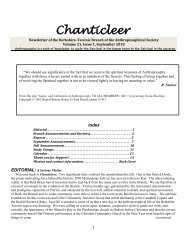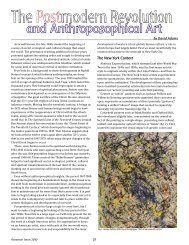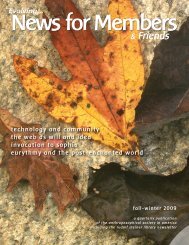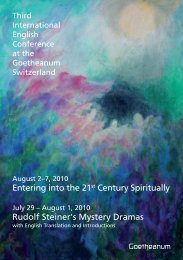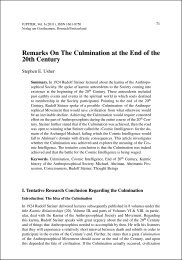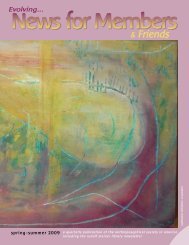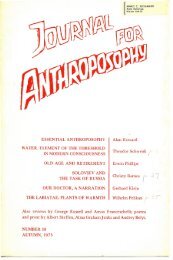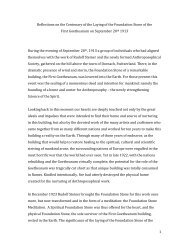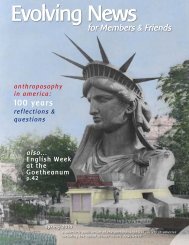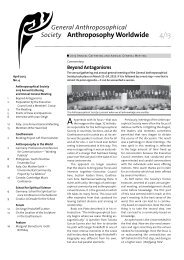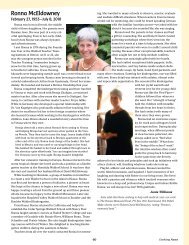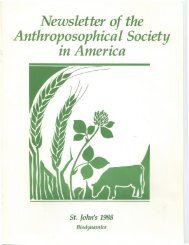Rudolf Steiner's Vision for the Future - Anthroposophical Society in ...
Rudolf Steiner's Vision for the Future - Anthroposophical Society in ...
Rudolf Steiner's Vision for the Future - Anthroposophical Society in ...
Create successful ePaper yourself
Turn your PDF publications into a flip-book with our unique Google optimized e-Paper software.
XXXXXXX The Language of Organisms<br />
This reliance upon <strong>the</strong> because of<br />
reason — a because closely bound<br />
up with all <strong>the</strong> mean<strong>in</strong>g of our own<br />
human lives — is no small th<strong>in</strong>g.<br />
German shepherd to a golden retriever, or from a lung to a<br />
kidney. Likewise, when we <strong>in</strong>quire <strong>in</strong>to <strong>the</strong> communication<br />
between cells: we are not merely curious about <strong>the</strong> physical<br />
<strong>for</strong>ces imp<strong>in</strong>g<strong>in</strong>g on those cells; we are try<strong>in</strong>g to clarify a<br />
context of mean<strong>in</strong>g. The one cell is say<strong>in</strong>g someth<strong>in</strong>g to <strong>the</strong><br />
o<strong>the</strong>r, not just push<strong>in</strong>g aga<strong>in</strong>st it.<br />
A context of mean<strong>in</strong>g can be thought of <strong>in</strong> o<strong>the</strong>r terms<br />
as well. We can take it, <strong>for</strong> example, to be <strong>the</strong> organism’s<br />
unified <strong>for</strong>m <strong>in</strong> <strong>the</strong> fullest sense — not only its bodily <strong>for</strong>m<br />
(as a flexible, dynamic trajectory of development), but also<br />
<strong>the</strong> “shape” of its pattern of activity, its recognizable and<br />
irreducibly qualitative way of be<strong>in</strong>g, dist<strong>in</strong>ct <strong>for</strong> every species<br />
(Holdrege 1999). The <strong>for</strong>m <strong>in</strong> this broad sense is <strong>the</strong> particular<br />
character we recognize when we strive to apprehend<br />
<strong>the</strong> organism as a whole. That, <strong>in</strong> fact, is a crucial feature of<br />
every mean<strong>in</strong>gful context: it can be grasped only as a whole,<br />
which is to say that it cannot be grasped or expla<strong>in</strong>ed as a set<br />
of relations between discrete parts.<br />
Form, character, a tapestry of mean<strong>in</strong>g — <strong>the</strong>se provide<br />
<strong>the</strong> “someth<strong>in</strong>g more” that, as we found earlier, makes<br />
physics and chemistry <strong>in</strong>adequate to describe <strong>the</strong> organism.<br />
They also typify our way of th<strong>in</strong>k<strong>in</strong>g about be<strong>in</strong>gs, as<br />
opposed to th<strong>in</strong>gs. That is, <strong>the</strong>y require a language of<br />
directed <strong>in</strong>tention (respond, develop, adapt, regulate, and so<br />
on); an aes<strong>the</strong>tically colored language (everyth<strong>in</strong>g relat<strong>in</strong>g<br />
to health and disease, order and disorder, rhythm and<br />
dysrhythmia, harmony and disharmony); and a language of<br />
wholeness (unity, coord<strong>in</strong>ation, <strong>in</strong>tegration, organization). In<br />
fact, just about all <strong>the</strong> k<strong>in</strong>ds of mean<strong>in</strong>g we humans express<br />
<strong>in</strong> our words, thought, and activity f<strong>in</strong>d <strong>the</strong>ir analog <strong>in</strong> our<br />
descriptions of organisms. Not surpris<strong>in</strong>gly, <strong>the</strong>n, <strong>the</strong><br />
biologist directly <strong>in</strong>vokes mean<strong>in</strong>g itself <strong>in</strong> terms such as<br />
message, <strong>in</strong><strong>for</strong>mation, communication, and signal.<br />
This reliance upon <strong>the</strong> because of reason — a because<br />
closely bound up with all <strong>the</strong> mean<strong>in</strong>g of our own human<br />
lives — is no small th<strong>in</strong>g. Biologists have gone on <strong>for</strong><br />
40 • be<strong>in</strong>g human<br />
decades us<strong>in</strong>g this language while rema<strong>in</strong><strong>in</strong>g content never<br />
to reckon with it — and even effectively deny<strong>in</strong>g it with a<br />
contradictory language of mechanism and control. It seems<br />
to me past time <strong>for</strong> <strong>the</strong> reckon<strong>in</strong>g.<br />
The Inwardness of Be<strong>in</strong>gs<br />
Mean<strong>in</strong>g — at least when we are not try<strong>in</strong>g to reduce<br />
it to some narrow mechanical or ma<strong>the</strong>matical notion of<br />
<strong>in</strong><strong>for</strong>mation — derives from and expresses our <strong>in</strong>wardness.<br />
It is <strong>in</strong>separable from m<strong>in</strong>d, feel<strong>in</strong>g, volition, consciousness.<br />
And because, <strong>in</strong> our biological descriptions, we refer <strong>the</strong>se<br />
mean<strong>in</strong>gs to organisms, it appears we are ascrib<strong>in</strong>g <strong>in</strong>wardness<br />
to <strong>the</strong>se organisms. And so we are. But <strong>the</strong>re are<br />
important dist<strong>in</strong>ctions to be made.<br />
Biological mean<strong>in</strong>g need not be thought of <strong>in</strong> terms of<br />
our own consciousness. Everyone accepts that nei<strong>the</strong>r <strong>the</strong><br />
bird build<strong>in</strong>g a nest, nor <strong>the</strong> embryo “construct<strong>in</strong>g” a heart,<br />
nor aga<strong>in</strong> <strong>the</strong> cell regulat<strong>in</strong>g its genes is act<strong>in</strong>g accord<strong>in</strong>g to<br />
consciously experienced mean<strong>in</strong>gs. Likewise, <strong>the</strong> directed<br />
nature of cellular processes does not imply conscious,<br />
human-like purpose, and, more generally, <strong>the</strong> mean<strong>in</strong>g I<br />
have been referr<strong>in</strong>g to need not <strong>in</strong>volve anyth<strong>in</strong>g like our<br />
own conscious awareness.<br />
This is not to suggest, however, that mean<strong>in</strong>g is no<br />
longer mean<strong>in</strong>g. Our knowledge of ourselves <strong>in</strong><strong>for</strong>ms us<br />
that <strong>the</strong> because of reason can play out <strong>in</strong> less than full<br />
consciousness. We know that it weaves throughout <strong>the</strong><br />
psyche, conscious or o<strong>the</strong>rwise, all <strong>the</strong> way down through<br />
subconscious urge and habit to biologically rooted <strong>in</strong>st<strong>in</strong>ct.<br />
It is not so unexpected, <strong>the</strong>n, to discover mean<strong>in</strong>g-governed<br />
activities also at <strong>the</strong> molecular level, where <strong>the</strong>y manifest as<br />
regulation, organization, signal<strong>in</strong>g, responsiveness, and all<br />
<strong>the</strong> rest. Organisms, so far as <strong>the</strong> biologist has been able to<br />
determ<strong>in</strong>e, are alive and whole and engaged <strong>in</strong> activity<br />
shaped by relations of mean<strong>in</strong>g — a mean<strong>in</strong>g whose signature<br />
is recognizable all <strong>the</strong> way down.<br />
Our knowledge of ourselves<br />
<strong>in</strong><strong>for</strong>ms us that <strong>the</strong> because of<br />
reason can play out <strong>in</strong> less than<br />
full consciousness.



